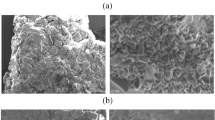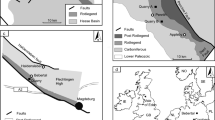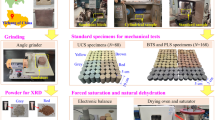Abstract
The paper reports on a study of the weak sandstones of the Shihti and Kweichulin Formations to the east of Taipei, Taiwan. The results indicate that the wave velocity and uniaxial compressive strength (UCS) of the samples decreased as water content increased, while wave velocity, UCS and slake durability increased with increasing porosity. Regression analyses demonstrated that wave velocity, UCS and slake durability decreased with increased quartz content. The values of these engineering properties also increased with a higher proportion of matrix/detritus, although the exact nature of the interrelationships between these factors is not clear.
Résumé
L’article présente une étude de grès tendres des formations de Shihti et Kweichulin à l’est de Taipeh (Taiwan). Les résultats indiquent que la vitesse du son et la résistance à la compression simple des échantillons diminuent quand la teneur en eau augmente et que la résistance à la compression simple et l’indice d’altérabilité augmentent quand la porosité augmente. Les analyses de régression ont montré que la vitesse du son, la résistance à la compression simple et l’indice d’altérabilité diminuent lorsque la teneur en quartz augmente. Par ailleurs, les valeurs de ces paramètres augmentent lorsque le rapport matrice/éléments détritiques augmente, bien que l’explication de cette relation ne soit pas claire.







Similar content being viewed by others

References
ASTM (1980) Annual book of ASTM standards—natural building stones. Soil and rock, part 19. American Society for Testing Materials, Philadelphia, 634 pp
Atkinson BK (1982) Subcritical crack propagation in rocks: theory, experimental results and applications. J Struct Geol 14:41–56
Barton ME, Mockett LD, Palmer SN (1993) An engineering geological classification of the soil/rock borderline materials between sands and sandstones. In: Cripps JC, Coulthard JM, Culshaw MG, Forster A (eds) The engineering geology of weak rock. Eng Group Geol Soc Spec Publ 8:125–138
Bell FG (1978) The physical and mechanical properties of the Fell Sandstones, Northumberland, England. Eng Geol 12:1–29
Bell FG, Culshaw MG (1993) A survey of the geotechnical properties of some relatively weak Triassic sandstones. In: Cripps JC, Coulthard JM, Culshaw MG, Forster A (eds) The engineering geology of weak rock. Eng Group Geol Soc Spec Publ 8:139–148
Bieniawski ZT (1984) Rock mechanics design in mining and tunneling. AA Balkema, Rotterdam
Brown ET (ed) (1981) Rock characterization, testing, and monitoring: ISRM suggested methods. Pergamon, Oxford, 211 pp
Gamble JC (1971) Durability–plasticity classification of shales and other argillaceous rocks. PhD Thesis, University of Illinois, Urbana
Geological Society London (1970) The logging of rock cores for engineering purposes. Q J Eng Geol 3(1):1–24
Gunsallus KL, Kulhaway FH (1984) A comparative evaluation of rock strength measures. Int J Rock Mech Min Sci Geomech Abst 21:233–248
Hawkins AB, McConnell BJ (1992) Sensitivity of sandstone strength and deformability to changes in moisture content. Q J Eng Geol 25:115–130
Ho CS (1986) An introduction to the geology of Taiwan: explanatory text of the geologic map of Taiwan. Ministry of Economic Affairs, Taipei, 164 pp
Huang CS (1988) No. 4 of Taiwan geological map. Central Geological Survey, Taipei, 46 pp
ISRM (1978) Suggested methods for the quantitative descriptions of discontinuities in rock masses. Int J Rock Mech Min Sci 15(6):319–368
Olivera R (1993) The engineering geology of weak rock. In: Cripps JC, Coulthard JM, Culshaw MG, Forster A (eds) Weak rock materials. Eng Group Geol Soc Spec Publ 8:5–15
Onodera TF, Asoka KHM (1980) Relation between texture and mechanical properties of crystalline rocks. Bull Int Assoc Eng Geol 22:173–177
Shakoor A, Bonelli RE (1991) Relationship between petrographic characteristics, engineering index properties and mechanics properties of selected sandstone. Bull Int Assoc Eng Geol 28:55–71
Ulusay R, Tureli K, Ider MH (1994) Prediction of engineering properties of a selected litharenite sandstone from its petrographic characteristics using correlation and multivariate statistical techniques. Eng Geol 37:135–157
Vutukuri VS, Lama RD, Saluja SS (1974) Handbook on mechanical properties of rocks. Trans Tech Publications, Clausthal, Germany, 280 pp
Yuan N (1996) The characteristics study of weak sandstone texture in east part of Taipei basin. MSc Thesis, National Taiwan University, Taipei, 130 pp
Acknowledgements
The authors extend their thanks to Prof. L.A. Lee, Institute of Statistic Analysis, Academy Sinica, and Prof. T.H. Huang, Department of Civil Engineering, National Taiwan University, Prof. C.L. Pan, Ministry of Economic Affairs, Dr. H.C. Lee, Department of Civil Engineering, Chungyun University, Dr. C.C. Chen, Sinotech Engineering Consultants, and Dr. Del Dobyns, Ming Chuan College, for their constructive comments. This study was supported by the National Science Council, China (NSC 86-2116-M-002-016).
Author information
Authors and Affiliations
Corresponding author
Rights and permissions
About this article
Cite this article
Chen, H., Hu, ZY. Some factors affecting the uniaxial strength of weak sandstones. Bull Eng Geol Environ 62, 323–332 (2003). https://doi.org/10.1007/s10064-003-0207-4
Received:
Accepted:
Published:
Issue Date:
DOI: https://doi.org/10.1007/s10064-003-0207-4



